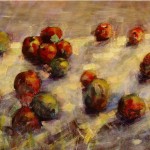
'Wild Apple Clusters' by Alice Kelsey - check out her work! alicekelsey.com
There have been quite a number of intriguing studies done on apple genetics recently, and this recent piece from the Public Library of Science Genetics Journal is no exception. Basically, our modern cultivated apples have not really diverged that much from their wild ancestors. Why is this interesting? It means that there is still unlimited possibility in creating new kinds of apples – cultivation has not destroyed the genetic diversity and potential of the species.
Here’s the abstract:
The apple is the most common and culturally important fruit crop of temperate areas. The elucidation of its origin and domestication history is therefore of great interest. The wild Central Asian species Malus sieversii has previously been identified as the main contributor to the genome of the cultivated apple (Malus domestica), on the basis of morphological, molecular, and historical evidence. The possible contribution of other wild species present along the Silk Route running from Asia to Western Europe remains a matter of debate, particularly with respect to the contribution of the European wild apple. We used microsatellite markers and an unprecedented large sampling of five Malus species throughout Eurasia (839 accessions from China to Spain) to show that multiple species have contributed to the genetic makeup of domesticated apples. The wild European crabapple M. sylvestris, in particular, was a major secondary contributor. Bidirectional gene flow between the domesticated apple and the European crabapple resulted in the current M. domestica being genetically more closely related to this species than to its Central Asian progenitor, M. sieversii. We found no evidence of a domestication bottleneck or clonal population structure in apples, despite the use of vegetative propagation by grafting. We show that the evolution of domesticated apples occurred over a long time period and involved more than one wild species. Our results support the view that self-incompatibility, a long lifespan, and cultural practices such as selection from open-pollinated seeds have facilitated introgression from wild relatives and the maintenance of genetic variation during domestication. This combination of processes may account for the diversification of several long-lived perennial crops, yielding domestication patterns different from those observed for annual species.

